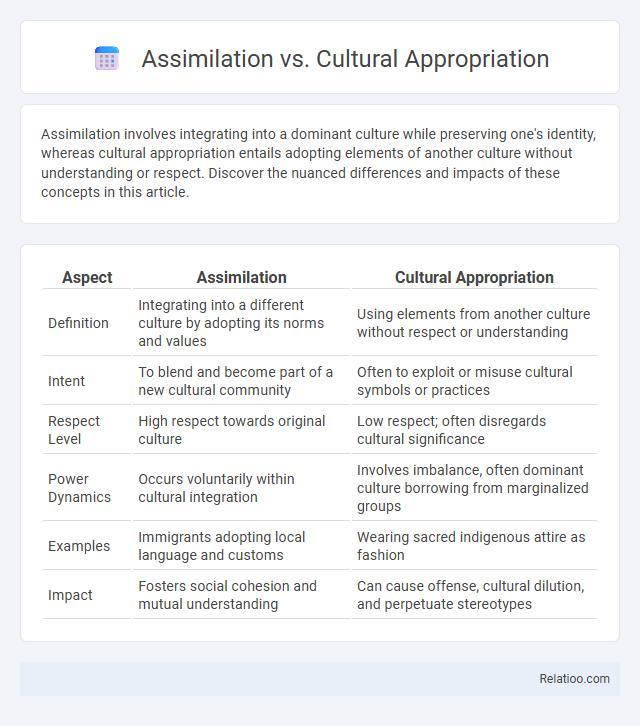Assimilation involves integrating into a dominant culture while preserving one's identity, whereas cultural appropriation entails adopting elements of another culture without understanding or respect. Discover the nuanced differences and impacts of these concepts in this article.
Table of Comparison
| Aspect | Assimilation | Cultural Appropriation |
|---|---|---|
| Definition | Integrating into a different culture by adopting its norms and values | Using elements from another culture without respect or understanding |
| Intent | To blend and become part of a new cultural community | Often to exploit or misuse cultural symbols or practices |
| Respect Level | High respect towards original culture | Low respect; often disregards cultural significance |
| Power Dynamics | Occurs voluntarily within cultural integration | Involves imbalance, often dominant culture borrowing from marginalized groups |
| Examples | Immigrants adopting local language and customs | Wearing sacred indigenous attire as fashion |
| Impact | Fosters social cohesion and mutual understanding | Can cause offense, cultural dilution, and perpetuate stereotypes |
Defining Assimilation: A Cultural Overview
Assimilation involves the process where individuals or groups fully integrate into a dominant culture, often adopting its language, customs, and values to achieve social acceptance and cohesion. This cultural integration can enhance social mobility but may also lead to the loss of original cultural identities. Understanding the distinction between assimilation, cultural appropriation, and acculturation helps you navigate complex cultural interactions with respect and awareness.
What is Cultural Appropriation?
Cultural appropriation occurs when elements of a marginalized culture are taken by a dominant culture without understanding, respect, or acknowledgment, often leading to misrepresentation or exploitation. Unlike assimilation, which involves integrating and adapting to a new culture often by choice or necessity, cultural appropriation lacks the reciprocal exchange and can perpetuate stereotypes or power imbalances. Your awareness of these distinctions is crucial to fostering respectful intercultural interactions and protecting cultural identities.
Key Differences Between Assimilation and Cultural Appropriation
Assimilation involves individuals or groups adopting the cultural traits of another community, often to integrate socially or economically, usually leading to a loss of original cultural identity. Cultural appropriation occurs when elements of a marginalized culture are taken by a dominant group without permission or understanding, often resulting in disrespect or commodification. The key difference lies in assimilation being a voluntary or necessary adaptation process, while cultural appropriation involves exploitation and lack of mutual respect.
Historical Contexts: Assimilation in Societies
Assimilation in historical societal contexts involved minority groups adopting the dominant culture's language, customs, and values to gain social acceptance and economic opportunities, often under government policies aimed at creating cultural homogeneity. Unlike cultural appropriation, which occurs when elements of a marginalized culture are taken without respect or understanding, assimilation frequently resulted in the erosion of the minority culture's identity and traditions. Your awareness of these distinctions highlights the complex dynamics of power, identity, and historical trauma embedded in cultural interactions.
The Roots and Rise of Cultural Appropriation
The roots of cultural appropriation trace back to colonialism and power imbalances, where dominant groups adopted elements of marginalized cultures without understanding or respecting their significance. The rise of cultural appropriation as a concept emerged alongside increased awareness of social justice and identity politics, highlighting the difference between appreciation and exploitation. Assimilation, by contrast, involves minority groups adapting to a dominant culture often under societal pressure, while cultural appropriation remains the act of borrowing without consent or recognition.
Impacts on Marginalized Communities
Assimilation often pressures marginalized communities to abandon their cultural identities to conform to dominant societal norms, leading to loss of heritage and psychological distress. Cultural appropriation, by contrast, involves dominant groups adopting elements of marginalized cultures without understanding or respect, resulting in misrepresentation and exploitation. Both processes reinforce systemic inequalities by undermining the value of marginalized identities and limiting authentic cultural expression.
Power Dynamics and Cultural Exchange
Power dynamics play a crucial role in distinguishing assimilation, cultural appropriation, and cultural exchange, where assimilation involves minority groups adapting to dominate cultural norms often under pressure or coercion. Cultural appropriation occurs when elements of a marginalized culture are taken by a dominant culture without permission, respect, or understanding, reinforcing inequalities and exploiting those cultural symbols. Your awareness of these distinctions helps promote respectful cultural exchange, which is characterized by mutual consent, equality, and appreciation across cultural boundaries.
Modern Examples: Assimilation vs Cultural Appropriation
Modern examples highlight assimilation as the process where minority groups adopt dominant cultural traits, often seen in immigrant communities blending language and customs for social integration. Cultural appropriation involves adopting elements of a marginalized culture by a dominant group without permission, exemplified by fashion brands using Indigenous designs without acknowledgment. Clear distinctions arise as assimilation reflects voluntary or pressured blending for acceptance, while appropriation entails exploitative borrowing lacking respect or context.
Navigating Cross-Cultural Interactions Ethically
Navigating cross-cultural interactions ethically requires understanding the distinctions between assimilation, cultural appropriation, and acculturation to respect individual identities and cultural heritage. Assimilation involves adopting the dominant culture's traits, often leading to the loss of original cultural identity, whereas cultural appropriation entails using elements of another culture without permission or understanding, which can perpetuate stereotypes and inequalities. Emphasizing informed cultural exchange and mutual respect fosters authentic connections and upholds ethical principles in multicultural environments.
Fostering Respectful Cultural Engagement
Fostering respectful cultural engagement requires understanding the distinctions between assimilation, cultural appropriation, and appreciation. Assimilation involves the absorption of minority cultures into a dominant culture, often at the expense of original cultural identities, while cultural appropriation occurs when elements of a marginalized culture are borrowed without permission or understanding, leading to disrespect or harm. Your approach should prioritize genuine appreciation and open dialogue, ensuring cultural exchange honors the origins and significance of traditions to promote mutual respect and inclusivity.

Infographic: Assimilation vs Cultural Appropriation
 relatioo.com
relatioo.com